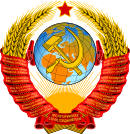This article includes a list of general references, but it lacks sufficient corresponding inline citations. (October 2008) |
| Languages of Soviet Union | |
|---|---|
| Official | Russian |
| Regional | Armenian, Azerbaijani, Belarusian, Estonian, Georgian, Kazakh, Kyrgyz, Latvian, Lithuanian, Moldovan (Romanian), Tajik, Turkmen, Ukrainian, Uzbek |
| Minority | Several minority languages. See distribution and status section for a full list. |
| Foreign | English, German |
| Part of a series on the |
| Culture of the Soviet Union |
|---|
 |
| People |
| Languages |
| Traditions |
| Cuisine |
| Festivals |
| Literature |
| Music |
| Sport |
The languages of the Soviet Union consist of hundreds of different languages and dialects from several different language groups.
In 1922, it was decreed that all nationalities in the Soviet Union had the right to education in their own language. The new orthography used the Cyrillic, Latin, or Arabic alphabet, depending on geography and culture. After 1937, all languages that had received new alphabets after 1917 began using the Cyrillic alphabet. This way, it would be easier for linguistic minorities to learn to write both Russian and their native language.[citation needed] Moreover, the Armenian and Georgian, as well as the Baltic Soviet Socialist Republics were the only Soviet republics to maintain their writing systems (Armenian, Georgian and Latin alphabets respectively).